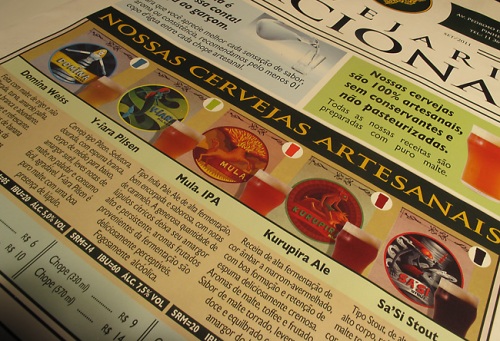One of the world’s oldest beverages, beer is mentioned in ancient Sumerian poetry, Egyptian texts, and Norse mythology. First brewed as early as 9500 BC, it remains beloved: after water and tea, it’s the third most popular drink worldwide. Though brewed primarily at home for millennia, these days most beer is commercially produced–a change that isn’t always an improvement.
Like any devotee, I love to try new beers, especially when traveling. This often creates disappointment, but every now and then lightning strikes and I find a new treasure. On a recent trip to Brazil, I followed my custom and tried some of the local beers–produced by large national breweries–and found them devoid of character and charm.
A quick internet search turned up a possible antidote, and a handful of us agreed to give it a whirl. The congested streets of Sao Paulo, a massive sprawl that covers over 750 square miles, hold many unlikely gems tucked between suco stands and airless shops crammed with cheap T shirts and bootleg DVDs. One such prize, in the center of Pinheiros, is Cervejaria Nacional–a small brew-pub that offers unpasteurized, preservative-free artisanal brews that are a welcome counter to the undistinguished ‘yellow beers’ found elsewhere.
The entry level showcases gleaming steel fermentation tanks behind plate-glass, an enticing promise that draws visitors upstairs to the bar or restaurant. In the bar, we read the legends of Brazilian spirits Y-iara, Mula, Kurupira, and Sa’Si, as well as the Domina Weiss (the ‘woman in white’ of folklore the world over), and tried to choose among their namesake brews. Chalkboards on the wall displayed SRM (Standard Reference Measure, a scale of color density), IBU (International Bitterness Units–pretty much just what it sounds like, and a reflection of a beer’s ‘hoppiness’ ), and alcohol content for the current batch of all five house-produced beers on tap.
The sampler, generous glasses of the whole quintet, sparked lively debate about our favorites, and of course required deeper exploration. Accompanied by spicy linguica, delicate farofa, light and crispy batatas frita da casa, tender cubes of polenta frita, and smoky vegetais grelhados, the weiss beer, IPA, and stout were savored by all as we discussed their flavor, color, and complexity. But for the melodic Portuguese being spoken all around us, and the fragrant remnants of the meal, we could have been in any bar, in any country, where beer is loved and celebrated.
Beer, it seems, is a lot like love. True believers speak a universal language, understood the world over. Malt or malte, cor or color, bouquet or aroma, it’s all about the mystery, experience, and exploration. What happy combination of soil and sunlight, hops and yeast, malt and time, shines in your glass like jewels bright on velvet, and how will it compare to others that have gone before? You never know until you taste, and that anticipation is a sweet intoxicant….near as sweet, and timeless, as the beer itself.






